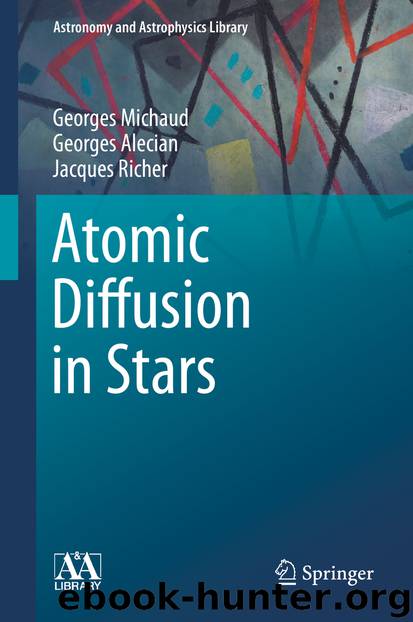Atomic Diffusion in Stars by Georges Michaud Georges Alecian & Jacques Richer

Author:Georges Michaud, Georges Alecian & Jacques Richer
Language: eng
Format: epub
Publisher: Springer International Publishing, Cham
Figure 9.9 illustrates the effect of varying the strength of turbulence on surface abundances. The different models vary in strength, in their depth dependence (value of n) and in anchorage [Eq. (7.24) or Eq. (7.26)]. For instance, in the 5.3D100-4 model the mixed zone extends down to the bottom of the iron peak convection zone while it is ten times deeper in mass in the 5.3D1M-4 model and another 2.5 times deeper in mass in the 5.4D1M-4 model. It is striking how little the patterns of anomalies change as turbulence changes: the curves practically never cross. It is only the overall size of anomalies that changes. This implies that, given an age and stellar mass, there is only one pattern of anomalies that can be predicted by these simple turbulence or mass loss models. The pattern is characterized by overabundances of iron peak elements and underabundances of species lighter than Na. Within each group, the relative anomalies also follow a simple dependence. An odd-even effect is apparent between Ne and Ca. It is caused by saturation of the radiation field which reduces g rad most for the more abundant even-Z elements. The insert illustrates that the elements which are most sensitive to details of models are around Ca and that one must be able to determine abundance anomalies to better than 0.1 dex if one is to distinguish between models.
Fig. 9.9Surface abundances in 2. 5 M models at 100 My. Each curve corresponds to the use of a different turbulence profile. They are labeled as follows (see § 7.3.3 for parameter definitions): (1) T5.30D100-4; (2) T5.30D200-4; (3) T5.30D1K-4; (4) T5.30D10K-4; (5) T5.30D10K-3; (6) R1K-2 (dot-dash); (7) T5.25D1M-4 (dotted); (8) T5.30D1M-4; (9) T5.40D1M-4 (dashed). Some isotopes are included, slightly shifted horizontally. Horizontal bars on the right show the spread of corresponding surface metallicities [Z∕H]. Effective temperatures range from 10,300 to 10,400 K. Inset: differences between anomalies of two more models (10 & 11) and those of model (4); (10, dotted) R92-3 has the same as (4), while (11, solid) R163-3 was adjusted to give a near perfect fit for helium at 100 My and has a slightly larger . From Richer et al. (2000), Fig. 12
Download
This site does not store any files on its server. We only index and link to content provided by other sites. Please contact the content providers to delete copyright contents if any and email us, we'll remove relevant links or contents immediately.
Tools of Titans by Timothy Ferriss(7815)
Turbulence by E. J. Noyes(7702)
Astrophysics for People in a Hurry by Neil DeGrasse Tyson(5002)
Secrets of Antigravity Propulsion: Tesla, UFOs, and Classified Aerospace Technology by Ph.D. Paul A. Laviolette(4994)
Design of Trajectory Optimization Approach for Space Maneuver Vehicle Skip Entry Problems by Runqi Chai & Al Savvaris & Antonios Tsourdos & Senchun Chai(4843)
Room 212 by Kate Stewart(4739)
Pale Blue Dot by Carl Sagan(4618)
The David Icke Guide to the Global Conspiracy (and how to end it) by David Icke(4381)
A Journey Through Divination and Astronomy by Publishing Pottermore(4250)
Apollo 8 by Jeffrey Kluger(3512)
Goodbye Paradise(3446)
Losing the Nobel Prize by Brian Keating(3425)
COSMOS by Carl Sagan(3348)
The Five People You Meet in Heaven by Mitch Albom(3335)
How to Read Water: Clues and Patterns from Puddles to the Sea (Natural Navigation) by Tristan Gooley(3240)
Brief Answers to the Big Questions by Stephen Hawking(3239)
How to Read Nature by Tristan Gooley(3079)
The Order of Time by Carlo Rovelli(3073)
A Brief History of Time by Stephen Hawking(2819)
